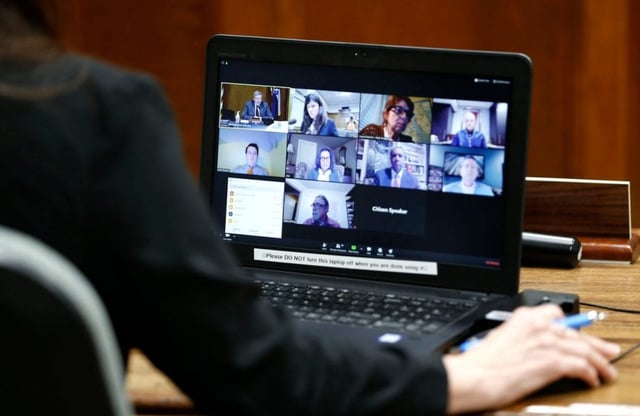Best Practices for CIOs and Local Gov Leaders Amid COVID-19 Crisis
.png)
Zencity
The Platform for Community Trust
With activitations of state of emergencies throughout the U.S. and self-isolation periods lasting beyond a month, the very fabric of society has been impacted . Many local government CIOs had contingency plans in place pre-corona, to ensure the uninterrupted continuation of operations in their district despite particular crises. However, in light of the unprecedented, rapid evolution of the COVID-19 outbreak and new technological challenges, CIOs have found themselves rushing to adapt to these tumultuous times. With no previous “coronavirus guide book” available for reference, many leaders must adjust on the fly. Leaders that possess accurate data to drive those decisions are often able to adapt more quickly and confidently, despite these uncertain times.
One of those data driven city leaders is Michael Pegues, CIO of Aurora, IL. On April 7th, Michael hosted a special webinar alongside Zencity, to discuss the acute needs and issues facing CIOs in the wake of the global pandemic. While each city across the country is facing a new set of challenges according to state declarations, confirmed case numbers, and unique economic needs, Michael took the time to share his experience from the City of Aurora, in the hopes of helping other local government leaders as they navigate this “new normal”.
To help you extract takeaways as quickly as possible, we’ve summarized 4 core challenges that were discussed in the webinar and how to tackle them effectively:
1. Effectively Communicating with Residents
Michael put it best when he said, “Open up the lines of communication with your team.” He also stressed the importance of having both internal and external conversations amongst colleagues and peers as a means to plan, strategize and anticipate. With more residents taking to the internet to voice their thoughts and concerns on COVID-19, this lends itself to data-based actionable insights that government leaders can rely on. In situations where time is of the essence, the ability to methodically communicate with one’s residents is a must.
-
Use data to streamline communication between internal teams and departments and take part in conversations with external sources. This can help fortify your city’s response methods and plan of action.
-
The rise in misinformation and disinformation across non-city owned channels has made it difficult for cities and local governments to ensure that the right messages are circulating amongst residents. There is an urgent need to actively track discourse on these channels to fully understand what their community is talking about when it comes to COVID-19. Zencity’s AI based technology is unique in that it can collect public discourse across city owned and non-city owned channels and help cities, like Aurora, quickly identify sources of misinformation in real time.
-
As a Zencity partner city, Aurora has been utilizing the Zencity dashboard regularly as a means of understanding its residents key concerns through online discourse, allowing Michael and his team to effectively allocate resources and communicate priorities internally and externally.
2. Digital Transformation and Moving to the Virtual Space
Traditionally, local government work is primarily conducted via face-to-face interactions. Now, this has proved rather difficult as public servants deal with and enforce new social distancing laws. Whereas, many local governments had begun implementing new technological systems into their daily activities, the full scale of the pandemic has led to local government teams having to fully rely on technology, implementing new systems, like call directories, collaboration tools and cloud based solutions. When it comes to new workforce technology, many won’t consider the government sector as early adopters. However, with this being considered the new normal, many municipalities are testing out new platforms and solutions, in hopes of increasing productivity and optimizing performance.
-
First and foremost, assess your current incident response plans and policies, in order to adjust and react in a concise manner and execute accordingly. As the majority of federal attention has been focused on national capacities, many local governments have been left by the wayside. This has led to the formation of groups like the Bloomberg coronavirus response network for mayors, an online network of mayors and public health experts helping communities deal with the spread of the novel coronavirus. You should seek out communities like these for guidance on managing medical facilities, handling quarantines, and providing overall support for residents who have fallen ill.
-
Cloud based solutions provide governments with the means and capabilities of using the technology ecosystem that is available in the physical office, while enabling them to work from home, with relatively few alterations.
-
Utilizing video conferencing and online meeting tools like Zoom have been a saving grace in community engagement. For example, Aurora, began hosting their city council meetings on Zoom in light of COVID-19. Zoom has truly proven its worth, especially in times of crisis, as Aurora city council members had a virtual turnout of 9500 citizens in their last meeting, compared to the 2400 people they average on their Facebook live streams, pre-corona.
-
CIOs need to embrace that city hall meetings are now digital and support its logistics. It is also necessary to seek out feedback from residents accordingly. Cities like Venice, FL, are making sure all bases are covered, providing their members a variety of participation options. These include: dialing in by phone, watching online passively, watching online and providing public commentary in real time and watching online and emailing, mailing or dropping off comments/questions before the proposed cut off time.
-
- Tackling the backend operations of virtual webinars has also taken some adapting. Governments are looking at tools like Docusign to get signatures remotely, from both government employees and residents.
3. Overcoming Supply Chain and Resource Challenges
One of the biggest obstacles that CIOs and local governments currently face is the lack of IT resources readily available and no means of production in sight. Aurora, IL, in particular, has 1,200 government employees and over 90% of them are currently working remotely. In times of calm, it is extremely important to perform due diligence as a means of developing a more efficient supply chain and delegation system for when the next unforeseen crisis occurs. With many local governments facing limited resources and a deteriorating economy, it is crucial to find a solution fast.
-
To put this in perspective, the city had approximately 10 laptops readily available for distribution within its municipality at the onset of the virus. Similarly, if you scale this across the U.S. it is apparent there is a huge need of thousands of personal computers and laptops across the governmental supply chain.
-
According to the Public Technology Institute, only 50% of local government tech officials said their organizations are ready to distribute laptops and mobile devices to employees who are ordered or decide to work from home during the ongoing coronavirus crisis.
-
-
Hardware isn’t the only thing in short supply for local governments throughout America. Software, effective infrastructure, Internet support, VPNs, etc., are all in high demand, with the majority of governments ill prepared, struggling to pick up the pieces.
-
Finding the right means of acquisition and distribution is vital. With the DOD and federal government first in line for prioritized resources, local governments are at a standstill. Many state officials, like Illinois’ Gov. Pritzker has turned to the federal government, requesting a new procurement legislation that would increase productivity of essential resources to help them manage the epidemic as best they can.0
4. Departmental Accessibility and Support

While there are many benefits of technology in the workforce, particularly in times of social distancing, there are also residual drawbacks. It is the CIO’s responsibility, alongside his or her team, to tackle these limitations appropriately, as some departments easily migrate to digital platforms, while others do not. How can this be done to ensure efficiency in the workplace?
-
Development services departments, which include code enforcements, building permits, property standards, public works, etc. are providing most of their forms online so they’re easily accessible. In Aurora, they have also begun conducting virtual inspections using tools like Duo, Zoom and Facetime.
-
Enacting these capabilities for these departments have shown them how valuable they are, as they are easy to utilize, and simultaneously, increase productivity. These methods are also being used to validate operational performance in areas where cost could be optimized.
-
-
However, more paper heavy departments, like that of Human Resources, are greatly in need of digitized services. The City of Aurora is using this time to prioritize the search for different services and digital tools which can be used to benefit these types of departments. For example, moving timesheets and paychecks online. The benefits of a more connected, digital workforce, will remain long after we finish the battle on coronavirus.
-
Pre-corona, Aurora’s police department and Water production group, were some of the city departments who had already begun moving into the digital space. This more readily prepared them and expedited their transition as early adopters. With no choice but to move departmental work online, department heads would be wise to look at the tools they have had to employ and determine what can be utilized long after the curve is flattened.
In Conclusion
While everyone has been affected by the COVID-19 pandemic, not everyone has been affected equally. From limited resources, to finite federal support and general technological hurdles, local government leaders must adapt rapidly and seek out strategic partnerships, alternative technologies and virtual solutions to help in their fight against coronavirus. Local government heads and CIOs, like Michael Pegues, are also leveraging online resident feedback data to understand their residents’ needs and service performance. By utilizing a tool like Zencity to swiftly gather and track thousands of public discourse data points in real time, the Aurora team is able to pinpoint their community’s needs and improve crisis management, recently leveraging our data to manage a tragic incident. To learn how our additional 130+ partner cities and counties are leveraging the Zencity platform in light of the pandemic, check out our COVID-19 Action Plan.
%20copy-1.png?width=544&height=120&name=Logo_black%20(1)%20copy-1.png)



